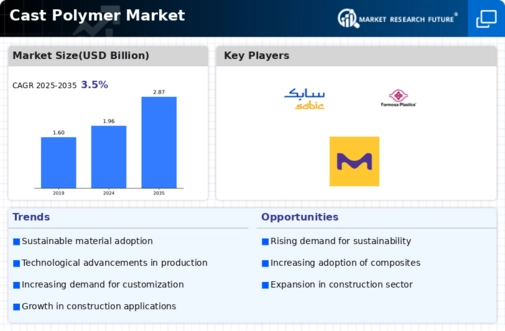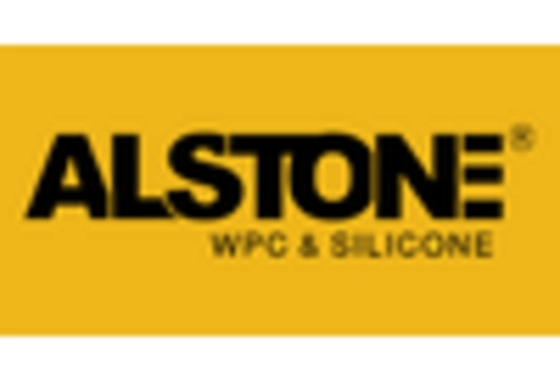Rising Demand for Durable Materials
The Cast Polymer Market experiences a notable increase in demand for durable materials across various sectors, including construction and automotive. As consumers and manufacturers prioritize longevity and resilience, cast polymers, known for their strength and aesthetic appeal, become increasingly attractive. The construction sector, in particular, is projected to account for a significant share of the market, driven by the need for materials that withstand environmental stressors. In 2025, the demand for cast polymers in construction applications is expected to rise by approximately 15 percent, reflecting a broader trend towards sustainable building practices. This shift not only enhances the market's growth potential but also aligns with the industry's focus on reducing waste and improving material efficiency.
Increasing Awareness of Aesthetic Appeal
The Cast Polymer Market benefits from a growing awareness of aesthetic appeal among consumers and designers. As interior design trends evolve, there is a marked preference for materials that offer both functionality and visual attractiveness. Cast polymers, available in a variety of colors and finishes, cater to this demand, making them a popular choice for countertops, sinks, and decorative elements. In 2025, the market is projected to grow by around 8 percent, driven by the increasing incorporation of cast polymers in residential and commercial design projects. This trend reflects a broader cultural shift towards personalized and visually engaging spaces, further solidifying the position of cast polymers in the market.
Sustainability and Eco-Friendly Practices
Sustainability emerges as a pivotal driver in the Cast Polymer Market, as consumers and businesses increasingly prioritize eco-friendly practices. The production of cast polymers often involves the use of recycled materials and sustainable manufacturing processes, appealing to environmentally conscious consumers. In 2025, the market is expected to see a growth rate of approximately 9 percent, as more companies adopt sustainable practices in their operations. This trend not only enhances the market's appeal but also aligns with global efforts to reduce carbon footprints and promote responsible consumption. As sustainability becomes a key consideration in purchasing decisions, the demand for cast polymers that meet these criteria is likely to rise.
Technological Innovations in Manufacturing
Technological advancements play a crucial role in shaping the Cast Polymer Market. Innovations in manufacturing processes, such as improved resin formulations and enhanced curing techniques, lead to higher quality products with better performance characteristics. These advancements enable manufacturers to produce cast polymers that are more resistant to wear, UV degradation, and chemical exposure. As a result, the market is likely to witness a surge in demand for high-performance cast polymers, particularly in sectors like automotive and aerospace. In 2025, the introduction of new technologies is expected to drive a market growth rate of approximately 12 percent, as companies leverage these innovations to meet evolving consumer preferences and regulatory standards.
Growth in Residential and Commercial Construction
The Cast Polymer Market is poised for growth, largely fueled by the expansion of residential and commercial construction activities. As urbanization accelerates, the need for innovative and aesthetically pleasing materials becomes paramount. Cast polymers, with their versatility and design flexibility, are increasingly utilized in countertops, sinks, and flooring solutions. In 2025, the construction sector is anticipated to contribute significantly to the market, with a projected growth rate of around 10 percent. This trend indicates a robust demand for cast polymers, as builders and architects seek materials that not only meet functional requirements but also enhance the visual appeal of spaces. The ongoing investment in infrastructure development further supports this growth trajectory.

















Leave a Comment